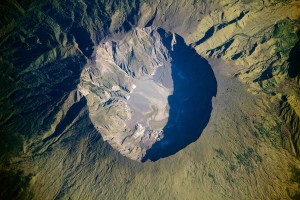27 December 2010
Extreme natural hazards span the globe
Posted by mohi
I lived in Houston, but our town was dusted by a fine layer of Washington state, 3000 kilometers (1850 miles) away. It was 1980 and Mount St. Helens had blown its top so violently, the entire continent knew it. But that’s really not that remarkable, according to a global database of explosive eruptions collected by Bristol University volcanologist Stephen Sparks (presented in FM10’s session on U13B). Similar studies reported throughout the conference–on volcanoes, landslides and tsunami–also assembled global databases of extreme geological hazards to better know when and where such threats might loom.

The 1815 eruption of Indonesia's Mount Tambora, seen here from space, was one of the most energetic eruptions in human history. When will another violent explosion like this one occur? Image courtesy of NASA
Volcanoes more than 50 times more explosive than St. Helens, which can unleash a cascade of long-lasting economic and societal disruptions, occur so often that most humans born today will see at least one. The Large Magnitude Explosive Volcanic Eruption database assembled by Sparks and collaborators also indicates that in the next 90 years, another eruption comparable to Indonesia’s Tambora’s explosion in 1815 has a one in four chance of recurring. Six hundred times larger than St. Helens, Tambora killed roughly 11,000 people in the initial blast and led to severe frosts in New England and Europe during May and June of 1816 (AKA, “the year without a summer”). These frosts destroyed agriculture, prompting a famine that lead to the deaths of an estimated 71,000.
Volcanoes aren’t the only extreme killers. Every year, landslides kill thousands of people. Since 2007, 12,000 have died from landslides, according to a global database of more than 2,400 rainfall-triggered landslides from the last three years presented by Dalia Kirshbaum (session PA33A). Oliver Korup assembled a global inventory of rarer, giant landslides (session EP32B). Some of these are so large they were only first detected from space. The speedy relocation of millions to billions of cubic meters of the crust can lead to other rapid landscape changes: overnight shifts in water flows, massive increases in sedimentation rates, and even increased mountain uplift. Colossal landslides can also trigger volcanic activity, according to Korup, by instantaneously reordering the balance of stresses on the cone, leading to rapid growth, eruption, or violent collapse of the volcano.
Korup’s database shows nearly 90 percent, by volume, of giant landslides occur under the ocean, and submarine slides tend to be the very largest observed. Such submarine slides can trigger tsunamis, as seen in a global database spanning the last 65 years, compiled by the USGS (reported in session S33B). But the database shows something even more interesting: the yearly rate of tsunamis seems to be increasing. Over the past 60 years, the rate is near 7.4 events per year, but the 1990s saw a three year sustained period with as many as 18 tsunamis. A current uptick sustained since 2005 averages 11 tsunamis per year. Scientists wonder: are the number of tsunami-producing earthquakes increasing, or is this bump in rate due to an increase in some other hazard that triggers tsunamis?
Researchers with NOAA’s National Geophysical Data Center in Boulder, Colo., extend the tsunami database well beyond the historical record, using case study reports of the physical evidence left behind by tsunamis that occurred sometimes hundreds of millions of years ago. The database (which they discussed in session OS31D) indicates that meteor impacts seem to have produced the very oldest evidence of tsunamis, but in the last ten thousand years, subduction zone earthquakes, volcano eruptions and collapses, and landslides pose the greatest risks.
Considering many of these natural hazards can create chaos in every type of economic activity, threats to food security and health care, mass human and environmental casualties and migrations, and even long-term climate crises, it’s in the interest of all humanity that scientists continue such work.
You can bet the 4 trillion dollar global insurance industry wants to move such scientific projects along. Rowan Douglas, of the reinsurer Willis Re, spoke in an invited talk to session U13B of his company’s efforts to promote extreme hazards research aimed at developing better scientific forecasts of such disasters and their globe-spanning impacts. Douglas also reflected on the rapid development of the hazard modeling field and its parallel rise in influence over massive monetary flows worldwide.
“What’s been fascinating for me today is to watch so many people show global pictures and global models of hazards in a way that we could never imagine just ten or twenty years ago,” he said. “These (projects), I think, are going to be incredibly powerful in the years ahead. Modeling here at the AGU is about to become a combat sport….because modeling can now consume and create capital. Natural catastrophe risk is the biggest single driver of capitalization in
insurance companies today.”
–Keith Rozendal is a science communication graduate student at UC Santa Cruz












 GeoSpace is a blog on Earth and space science, managed by AGU’s Public Information staff. The blog features posts by AGU writers and guest contributors on all sorts of relevant science topics, but with a focus on new research and geo and space sciences-related stories that are currently in the news.
GeoSpace is a blog on Earth and space science, managed by AGU’s Public Information staff. The blog features posts by AGU writers and guest contributors on all sorts of relevant science topics, but with a focus on new research and geo and space sciences-related stories that are currently in the news.